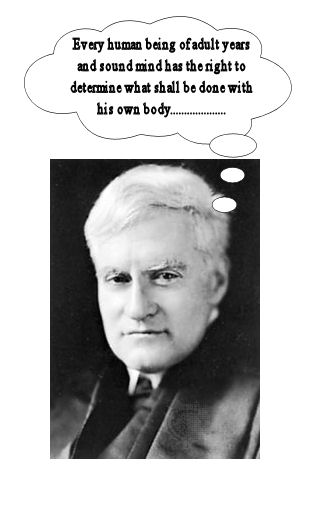Informed Consent
Basic Principles
Canadian law on informed consent has been developed initially through United States and then Canadian case law.
The first most important case to establish any principle of disclosure was:
Schloendorff v. Society of New York Hospital, 211 N.Y. 125, 105 N.E. 92 (1914)
In this case unauthorized uterine surgery was complicated by gangrene and amputation of several fingers.
and Justice Benjamin Cardozo made the celebrated statement:
“Every human being of adult years and sound mind has the right to determine what shall be done with his own body; and a surgeon who performs an operation without his patient's consent commits an assault, for which he is liable in damages, except in cases of emergency where the patient is unconscious, and where it is necessary to operate before consent can be obtained.”
Please also see: Justice Benjamin Cardozo (Historical Society of the Courts of the State of New York)
To read the opinion follow this link to LSU's Law Center: Medical and Public Health Law Site: Basic right to consent to medical care - Schloendorff v. Society of New York Hospital, 211 N.Y. 125, 105 N.E. 92 (1914)

Autonomy
Information is given to serve patient “autonomy” – that is the right of self determination – from Greek (auto = self, nomos = rule) – to make appropriate and sufficiently informed decisions that accord with the patient’s own wishes.
This enables patients to maintain ultimate control of decisions that affect them and pursue goals that are important to them.
Health care professionals (HCPs) should provide information that is material (important to the patient), so that choice can be exercised.


